
Printmaking is the process of creating artworks by printing, normally on paper, but also on fabric, wood, metal, and other surfaces. "Traditional printmaking" normally covers only the process of creating prints using a hand processed technique, rather than a photographic reproduction of a visual artwork which would be printed using an electronic machine ; however, there is some cross-over between traditional and digital printmaking, including risograph.
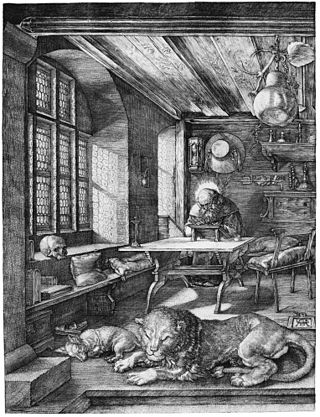
Engraving is the practice of incising a design onto a hard, usually flat surface by cutting grooves into it with a burin. The result may be a decorated object in itself, as when silver, gold, steel, or glass are engraved, or may provide an intaglio printing plate, of copper or another metal, for printing images on paper as prints or illustrations; these images are also called "engravings". Engraving is one of the oldest and most important techniques in printmaking.

Woodcut is a relief printing technique in printmaking. An artist carves an image into the surface of a block of wood—typically with gouges—leaving the printing parts level with the surface while removing the non-printing parts. Areas that the artist cuts away carry no ink, while characters or images at surface level carry the ink to produce the print. The block is cut along the wood grain. The surface is covered with ink by rolling over the surface with an ink-covered roller (brayer), leaving ink upon the flat surface but not in the non-printing areas.

Wood engraving is a printmaking technique, in which an artist works an image into a block of wood. Functionally a variety of woodcut, it uses relief printing, where the artist applies ink to the face of the block and prints using relatively low pressure. By contrast, ordinary engraving, like etching, uses a metal plate for the matrix, and is printed by the intaglio method, where the ink fills the valleys, the removed areas. As a result, the blocks for wood engravings deteriorate less quickly than the copper plates of engravings, and have a distinctive white-on-black character.

Intaglio is the family of printing and printmaking techniques in which the image is incised into a surface and the incised line or sunken area holds the ink. It is the direct opposite of a relief print where the parts of the matrix that make the image stand above the main surface.
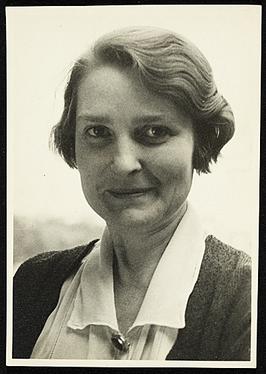
Grace Thurston Arnold Albee was an American printmaker and wood engraver. During her sixty-year career life, she created more than two hundred and fifty prints from linocuts, woodcuts, and wood engravings. She received over fifty awards and has her works in thirty-three museum collections. She was the first female graphic artist to receive full membership to the National Academy of Design.

Stanley William Hayter was an English painter and master printmaker associated in the 1930s with surrealism and from 1940 onward with abstract expressionism. Regarded as one of the most significant printmakers of the 20th century, in 1927 Hayter founded the influential Atelier 17 studio in Paris. Since his death in 1988, it has been known as Atelier Contrepoint. Among the artists who frequented the atelier were Pablo Picasso, Alberto Giacometti, Joan Miró, Alexander Calder, Marc Chagall, Nemesio Antúnez, Jackson Pollock, Mark Rothko, Wassily Kandinsky, Mauricio Lasansky, K.R.H. Sonderborg, Flora Blanc, Carl Heywood, and Catherine Yarrow.
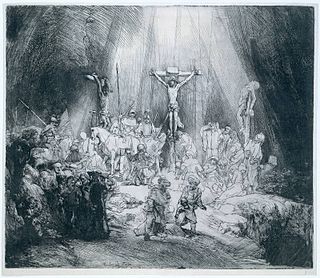
An old master print is a work of art produced by a printing process within the Western tradition. The term remains current in the art trade, and there is no easy alternative in English to distinguish the works of "fine art" produced in printmaking from the vast range of decorative, utilitarian and popular prints that grew rapidly alongside the artistic print from the 15th century onwards. Fifteenth-century prints are sufficiently rare that they are classed as old master prints even if they are of crude or merely workmanlike artistic quality. A date of about 1830 is usually taken as marking the end of the period whose prints are covered by this term.

The Grosvenor School of Modern Art was a private British art school and, in its shortened form, the name of a brief British-Australian art movement. It was founded in 1925 by the Scottish wood engraver Iain Macnab in his house at 33 Warwick Square in Pimlico, London. From 1925 to 1930 Claude Flight ran it with him, and also taught linocutting there; among his students were Sybil Andrews, Cyril Power, Lill Tschudi and William Greengrass.
Paul Hambleton Landacre was an American artist based in Los Angeles. His artistic innovations and technical virtuosity gained wood engraving a foothold as a high art form in twentieth-century America. Landacre's linocuts and wood engravings of landscapes, still lifes, nudes, and abstractions are acclaimed for the beauty of their designs and a mastery of materials. He used the finest inks and imported handmade Japanese papers and, with a few exceptions, printed his wood engravings in his studio on a nineteenth-century Washington Hand Press, which is now in the collection of the International Printing Museum in Carson, California.
Angie Lewin is a British printmaker working in linocut, wood engraving, lithography and screen printing.

Stipple engraving is a technique used to create tone in an intaglio print by distributing a pattern of dots of various sizes and densities across the image. The pattern is created on the printing plate either in engraving by gouging out the dots with a burin, or through an etching process. Stippling was used as an adjunct to conventional line engraving and etching for over two centuries, before being developed as a distinct technique in the mid-18th century.
Leonard Beaumont (1891–1986) was an English printmaker, graphic designer, illustrator and publisher. He was one of the earliest exponents of the new art of linocut printmaking in Britain during the early 1930s. He was one of a small group of progressive and highly regarded printmakers who exhibited at the Redfern and Ward Galleries in central London. Whilst working in relative isolation in Yorkshire, most of his contemporaries were linked in some way to the Grosvenor School of Modern Art, located in Pimlico, London.

George Alexander Walker is a Canadian artist and writer best known for his wood engravings and wordless novels.
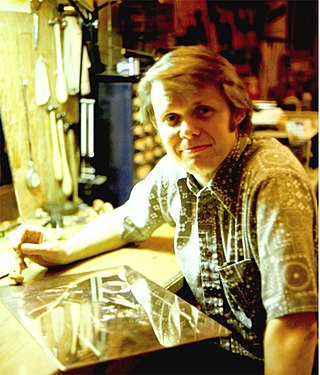
Evan Lindquist is an American artist and printmaker who was appointed to be the first Artist Laureate for the State of Arkansas. He has concentrated on the medium of copperplate engraving for more than 50 years. His compositions are memorable for their emphasis on calligraphic lines.
Anne Desmet is a British artist who specializes in wood engravings, linocuts and mixed media collages. She has had three major museum retrospectives, received over 30 international awards, and her work is in museum collections and publications worldwide.
Hilary Jasmine Erica Paynter is a British wood engraver and printmaker.
Mary Elizabeth Groom was a British artist, notable for her work as a printmaker and for the books she illustrated in the 1930s for the Golden Cockerel Press.
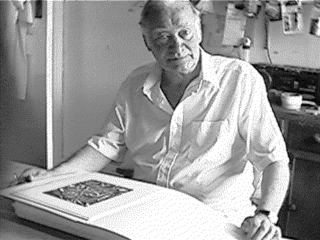
James Bostock was a British painter. His work was part of the painting event in the art competition at the 1948 Summer Olympics.
Master printmakers or master printers are specialized technicians who hand-print editions of works of an artist in printmaking. Master printmakers often own and/or operate their own printmaking studio or print shop. Business activities of a Master printshop may include: publishing and printing services, educational workshops or classes, mentorship of artists, and artist residencies.












